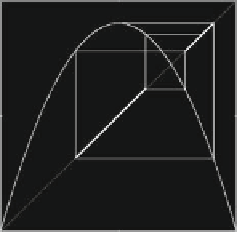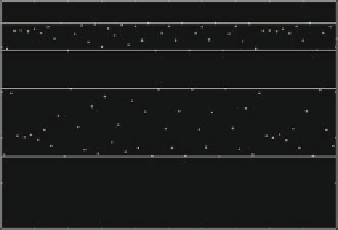Chemistry Reference
In-Depth Information
generated from an initial condition in .0;1/,entersŒc
1
;cafter a finite number of
iterations. Following the terminology introduced in Mira et al. (1996), the interval
Œc
1
;cis called
absorbing
.
In general, for an n-dimensional map, an
absorbing region
A
R
(intervals in
,
3
;:::) is defined as a bounded set whose boundary is
given by portions of the critical set CS and its images of increasing order CS
k
R
2
, volumes in
R
areas in
D
T
k
.CS/, such that a neighborhoodU
A
exists whose points enter
A
after a finite
number of iterations and then never escape it, since T.
A
/
A
, which is to say that
A
is trapping (see for example Mira et al. (1996) for more details).
Loosely speaking, we can say that the iterated application of a noninvertible map,
folding and folding again the space, defines trapping regions bounded by critical sets
of increasing order.
Sometimes, smaller absorbing regions are nested inside a bigger one. This can
be illustrated, again, for the logistic map (C.1), as shown in Fig. C.6a, where inside
the absorbing interval Œc
1
;c a trapping subset is obtained by higher rank images
of the critical point, given by
A
D
Œc
1
;c
3
[
Œc
2
;c.InFig.C.6bitisshownthat,
for the same parameter value
D
3:61 as in Fig. C.6a, the numerical iteration of the
logistic map gives points that are trapped inside the two-cyclic interval
.
Inside an absorbing region one or more attractors may exist. However, if a chaotic
attractor exists which fills up a whole absorbing region then the boundary of the
chaotic attractor is formed by portions of critical sets. This is the situation shown
in Fig. C.6a, b, where the absorbing interval
A
A
D
Œc
1
;c
3
[
Œc
2
;cis invariant and
filled up by a chaotic trajectory,asshowninFig.C.6b.
To better illustrate the foregoing point, we also give a two-dimensional example,
obtained by using the map (C.5). In Fig. C.7a, a chaotic trajectory is shown, and in
Fig. C.7b its outer boundary is obtained by the union of a segment of LC and three
iterates LC
i
D
T
i
.LC/, i
D
1;2;3.
1
x
t
c
c
c
2
=
f
(
c
1
)
c
3
=
f
(
c
2
)
.8
c
2
c
3
.6
.4
c
1
=
f
(
c
)
c
1
.2
0
10
20
30
40
50
60
70
80
90
t
100
0
1
(a)
(b)
Fig. C.6
Illustrating a trapping subset inside the absorbing set of Fig. C.5 for the quadratic map
with
D
3:61.(
a
) The delineation of the trapping subset Œc
1
;c
3
[
Œc
2
;c.(
b
) The iterates of the
map remain trapped inside the two cyclic interval


Search WWH ::

Custom Search